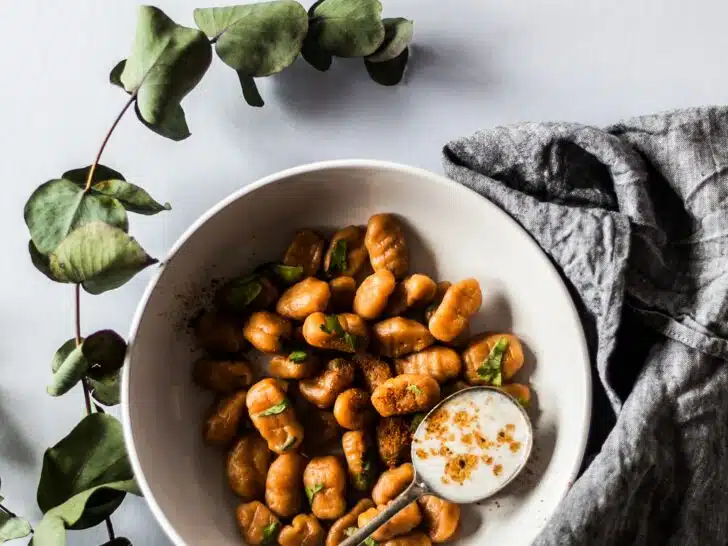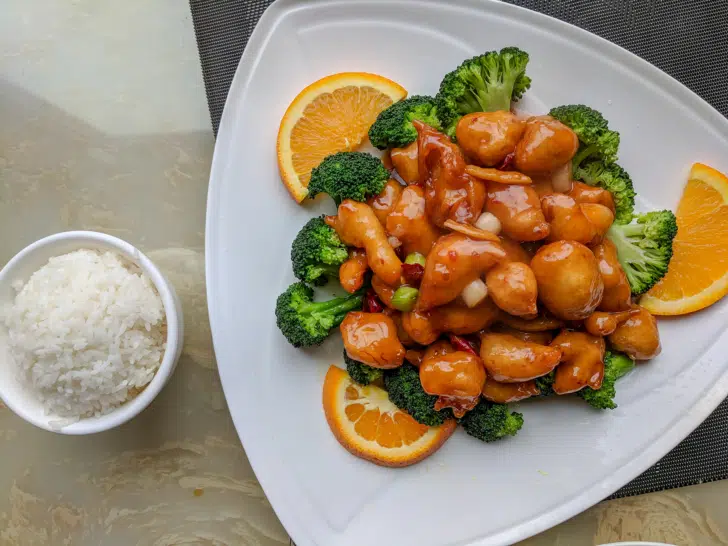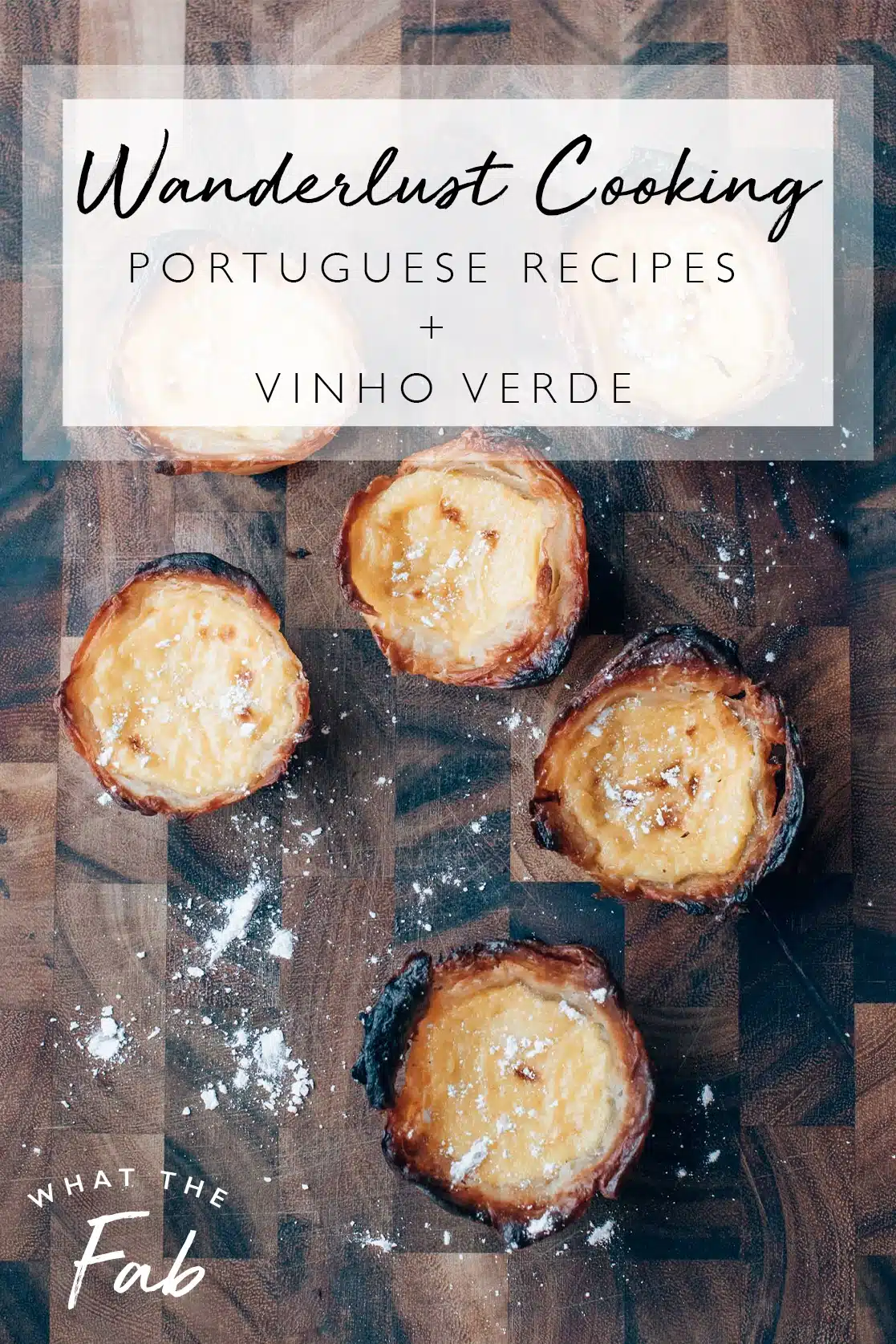
Today’s post is the fourth edition in my Wanderlust Cooking series! So far, we’ve done Mexico, France, and Italy. And today we’re heading to drum roll please, … Portugal!

Omied and I were supposed to be in Portugal last week—we’ve never been before and we were so excited to visit a new country. I’ve heard so many amazing things about Portugal’s cities, beaches, and wine regions.
I’m particularly excited about today’s Wanderlust Cooking post because I’m partnering with Vinho Verde, a wine region in northern Portugal.
Perhaps we would have visited Vinho Verde during our Portugal trip, but since that isn’t possible during these times, we got to bring a taste of Vinho Verde to us, along with some Portuguese recipes that I made to pair with our wines.

Since Vinho Verde might be a new region to you, here are some interesting facts about it:
– Vinho Verde is the name of the region, not the wine or the varietal. The region has nine sub-regions, each with its own microclimate.
– Vinho Verde doesn’t mean “green wine.” Don’t listen to Wikipedia here—the “verde” in the name comes from the lush, green, rolling hills of the region. Not young grapes.
– The wines of Vinho Verde can be classified into two segments:
Young segment: crisp, light, and fresh. The young segment is traditionally the most popular segment, and to me is perfect on a warm summer day.
Premium segment: intense, complex, and mineral. The premium segment is great for food pairing.
– All the grapes in the region are indigenous. Some of the grapes are Alvarinho, Avesso, Azal, Arinto, Loureiro or Trajadura.
– Portuguese culture has a history of winemaking. The Portuguese were already making fermented drinks when the Romans arrived 2000 years ago. Wine in Portugal is part of daily life, and many families have a small plot of land where they grow their own grapes next to their vegetables and citrus trees. Which sounds like the dream to me.
– The young Vinho Verde wines are slightly sparkling. Young, white Vinho Verdes wines are light and fresh, thanks to their natural acidity. Since they have less than one bar of CO2 pressure, they don’t quite qualify as semi-sparkling wines, but they’re still slightly sparkling.
I had never cooked Portuguese food before so I was excited to research Portuguese recipes and try something new. A lot of Portuguese recipes I found involved rice (Portuguese paella!), soup, seafood, or roasted meats like chicken, pork, or sausage. They all looked so good so it was hard to narrow it down, but here’s what I ended up landing on:
Portuguese Salad (with roasted vegetables and a red wine vinaigrette)
Empadão (similar to a shepherd’s pie and SO good)
Pasteis de Nata (amazing sweet egg tart pastries)
If I had a little more steam left in me I would have tried making a stew recipe for a second course—I saw a really yummy looking kale and pork one—or traditional salt cod fritters. But these three dishes were all great and we had so much fun pairing Vinho Verde wines with our dinner and getting a taste of Portugal while staying at home. If you’re looking to explore and try something new while staying in, I definitely recommend these recipes and trying some Vinho Verde wines paired with them!
If you’re looking to get more into Portuguese cooking, check out these cookbooks:
Here’s my Spotify playlist for listening to while you’re cooking up some Portuguese recipes!
Ok, let’s get into all the delicious recipes!
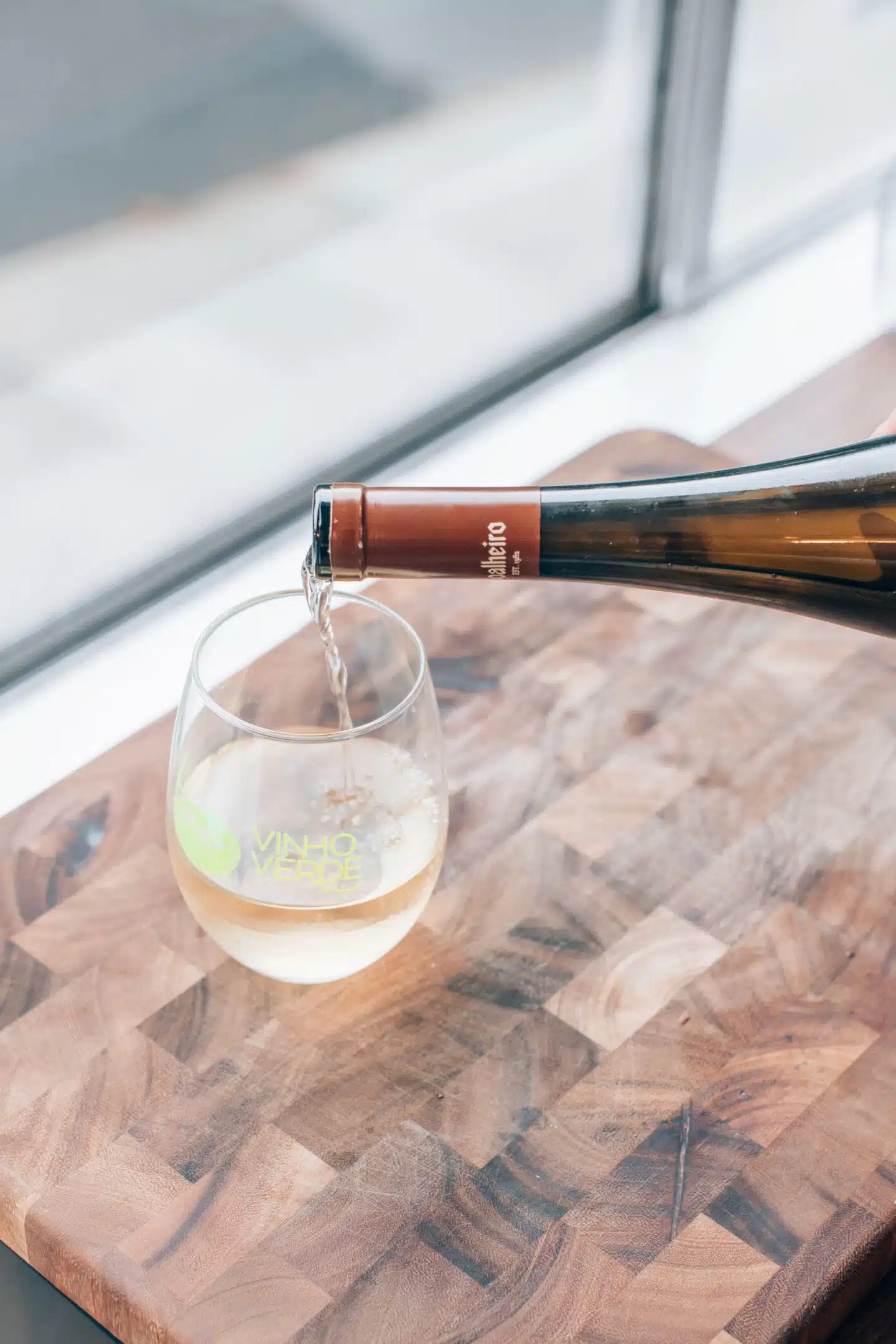
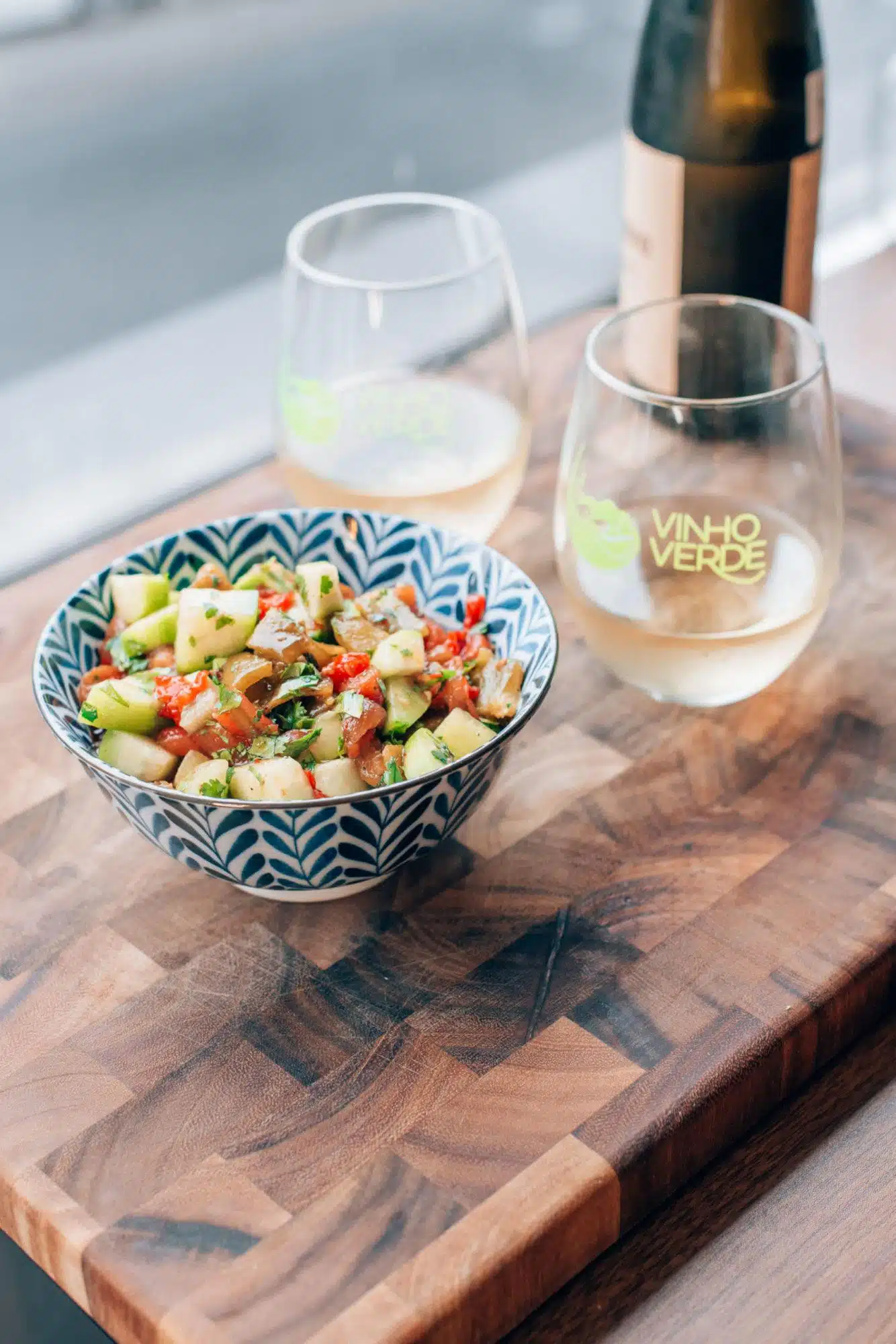
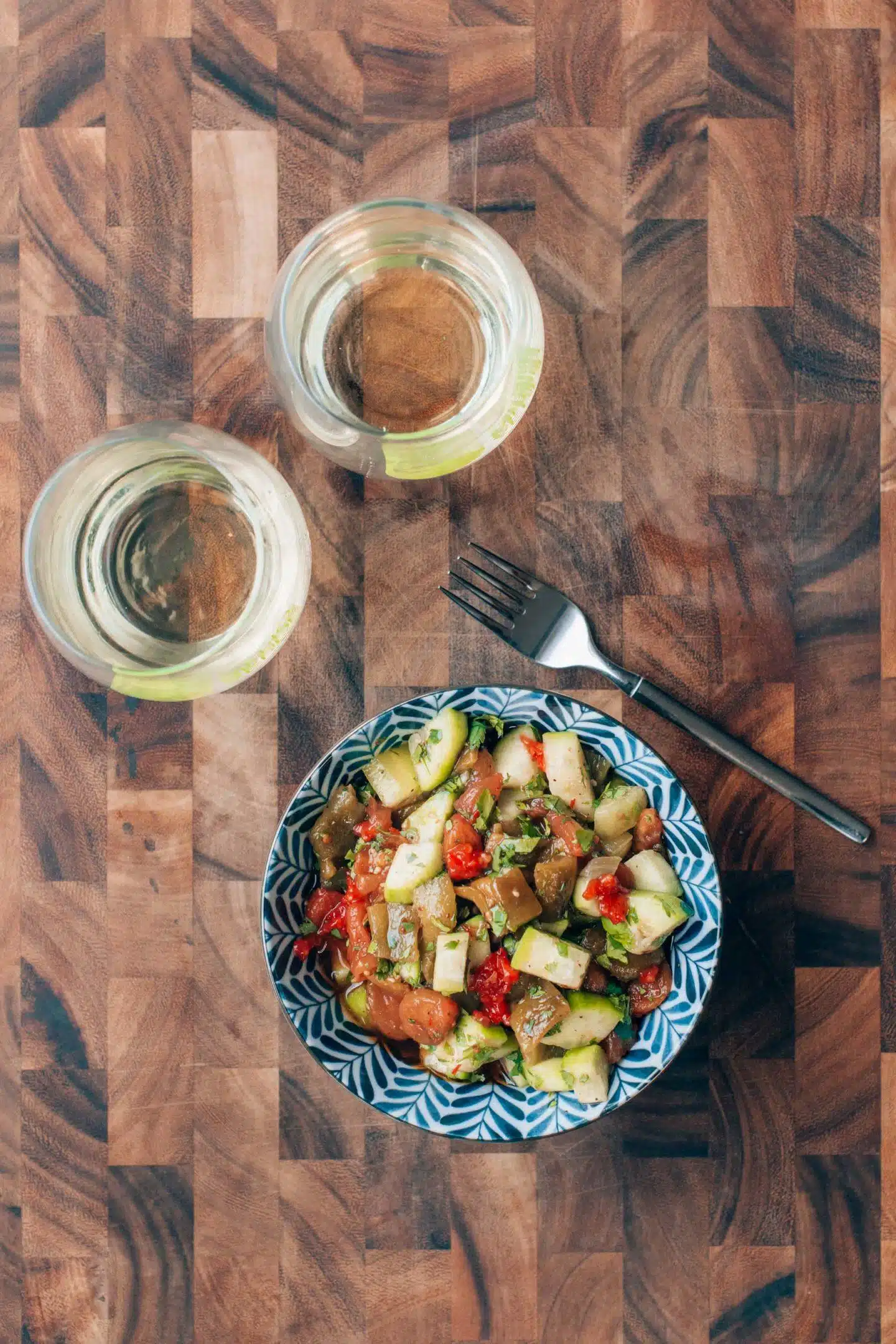
Portuguese Salad Recipe
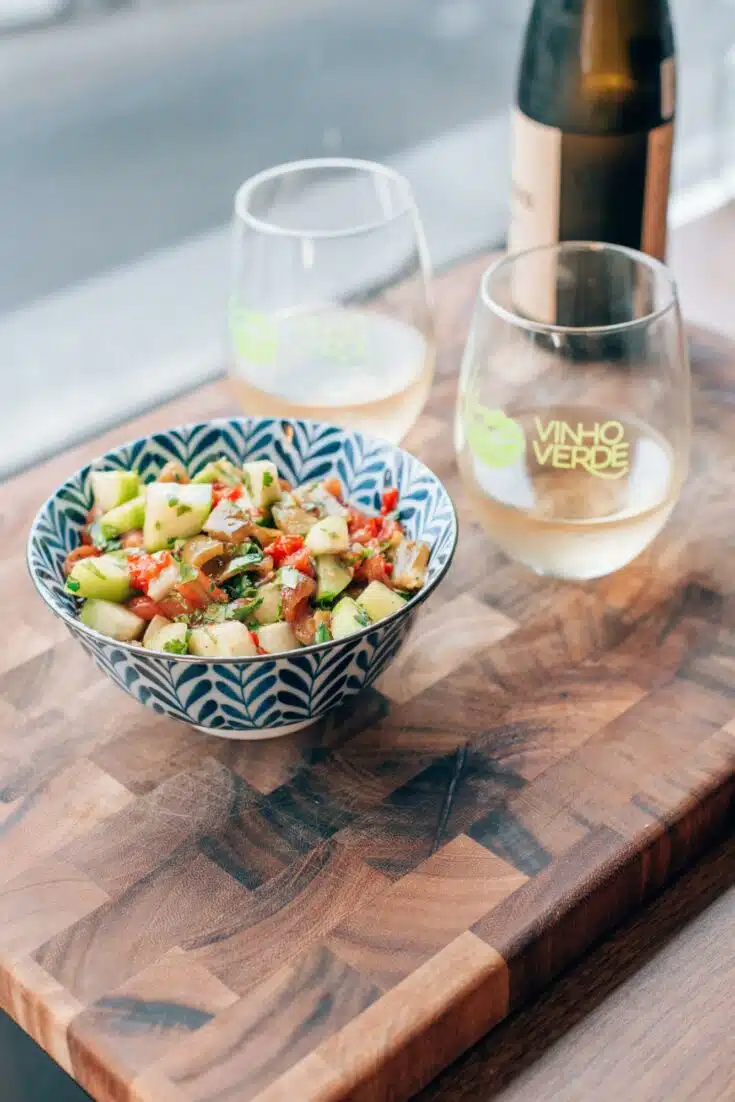
This Portuguese salad recipe from Recipe Girl is easy to make and so flavorful. The roasted vegetables with red wine vinaigrette makes for a tangy, mouthwatering salad.
Ingredients
- 3 medium green bell peppers
- 6 medium plum tomatoes
- 1/2 cup extra-virgin olive oil
- 2 medium cucumbers, peeled & sliced 1/2-inch thick
- kosher or sea salt
- 2/3 cup coarsely chopped fresh cilantro
- 1/4 cup red wine vinegar
- 2 teaspoons chili garlic paste
Instructions
Roast Bell Peppers and Tomatoes:
1. You can roast the peppers and tomatoes on gas burner, on broil in the oven, or on a grill. Place peppers either directly on burner grates, on a baking sheet in the oven, or directy on grill to roast, turning occasionally with tongs until the skin is blistered and black all over. Remove from heat and set aside.
2. Brush tomatoes with olive oil and place close to the heat, turning and roasting as the skin blisters all over, about 3 minutes. It's ok if the skin gets blackened, but roast them quickly so the flesh doesn't get overcooked. Set aside to let cool.
3. After the bell peppers have cooled, peel off the skins, remove the core and seeds, and cut them into pieces that are about 1-inch-square (or triangles). Peel the tomatoes and cut them into pieces about the same size as the peppers.
4. Meanwhile, place cucumber slices on a rack set over a baking sheet or in a colander and sprinkle them lightly with salt on both sides. Allow them to stand for 20 minutes to release their juices, then pat dry with paper towels.
Assemble the Salad:
1. Combine roast peppers, tomatoes, and cucumbers in a large salad bowl and sprinkle with the chopped cilantro.
2. Stir in the remaining olive oil, red wine vinegar, and chile paste and toss to combine. Season with salt and pepper. If you're not serving the salad right away, cover and refrigerate, but pull out the salad and let it stand at room temperature for 30 minutes before serving.
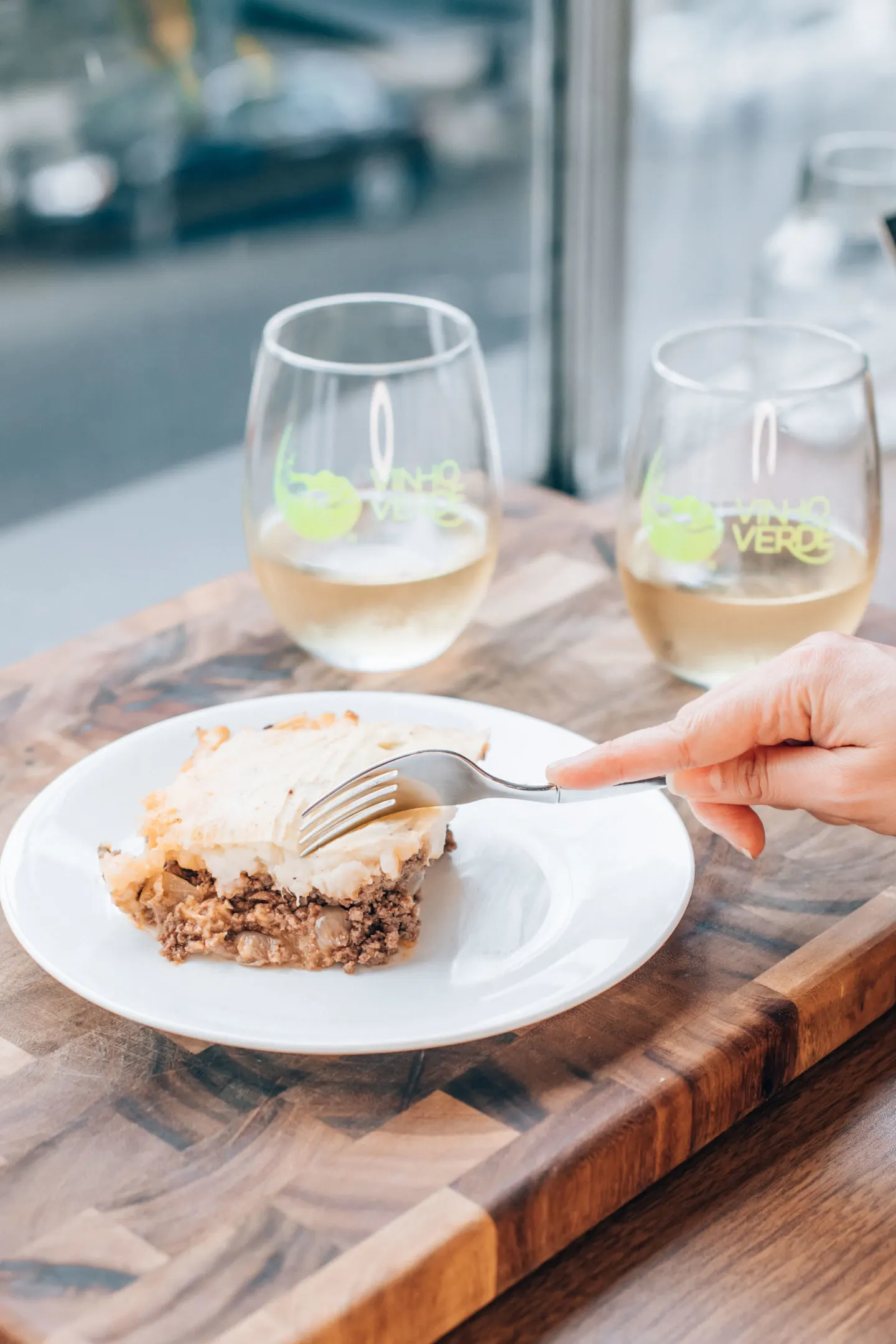
Empadão
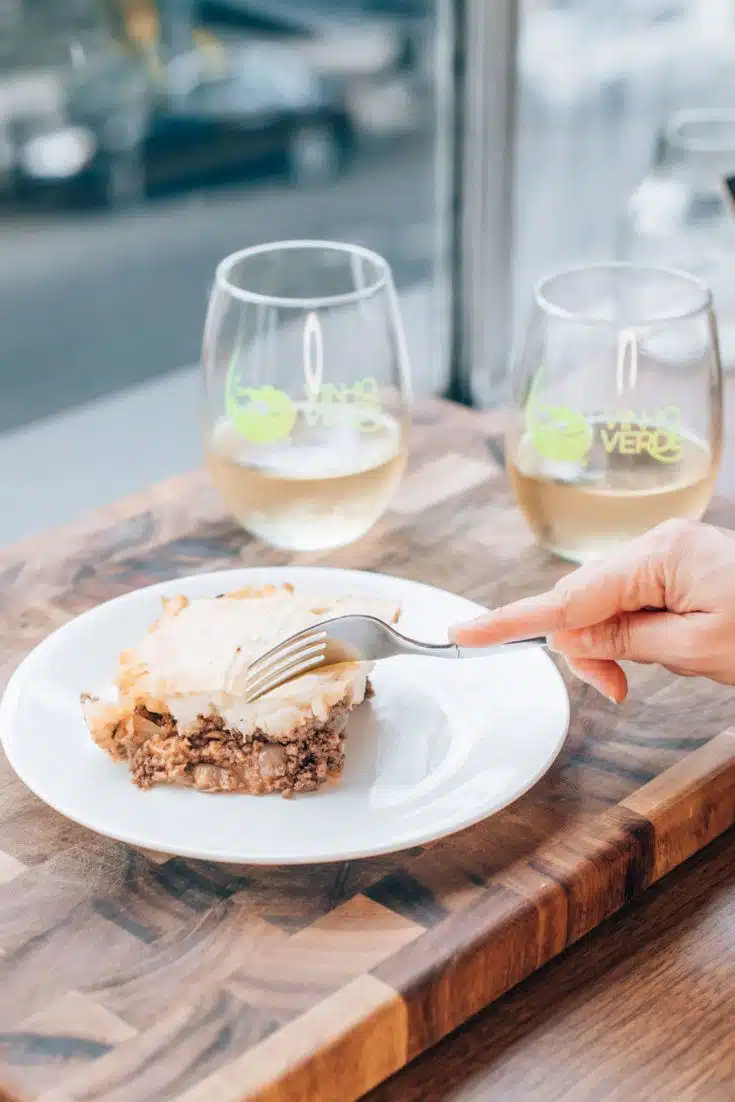
Empadão is like a Portuguese shepherd's pie (which is one of my favorite comfort foods), and can be made with different meats like chicken (Empadão Frango), or beef, like in this recipe. It's not difficult to make, and you'll have a large casserole dish of delicious Empadão to enjoy for a few days!
Ingredients
- 2 lbs ground beef
- 1 onion, chopped
- 1 bell pepper, chopped
- 2 cloves of garlic, chopped
- 2 tablespoons of tomato paste
- 1 tablespoon of hot pimento paste
- 1 teaspoon of black pepper
- 1 tablespoon of paprika
- 1 teaspoon of mustard
- 1/2 tablespoon of salt
- 3 tablespoons of olive oil
- 1 cube chicken or beef knorr
- 1/4 cup of red wine
- 10 medium potatoes
- 2 tablespoons butter
- 1 cup milk
- 1 egg (for egg wash)
Instructions
For the Meat Filling
1. Over medium heat, add the olive oil, onion, garlic, bell pepper to a medium pot and cook for a few minutes, than add tomato paste, hot pimento paste, mustard, knorr cube, paprika, black pepper, wine, salt and finally the ground beef, stir well and let it cook for 15 minutes or until cooked, and remove from heat.
2. Preheat the oven to 180°C or 350°F.
For the Mashed Potatoes
1. Bring a pot of salted water to a boil. Add potatoes and cook until tender but still firm, about 25 minutes; drain.
2. Add butter and milk to the pot and mash with potatoes until smooth and creamy. Season with salt and pepper to taste (and remember the meat filling will have salt in it already too!).
Assemble the Empadão
1. Grease a medium casserole dish with olive oil.
2. Add a layer of mashed potatoes, then a layer with all the cooked ground beef, then top it off with the remaining mash potatoes
3. Brush the egg wash over the mashed potatoes.
4. Cook for 30 minutes, let it cool for a bit and serve.
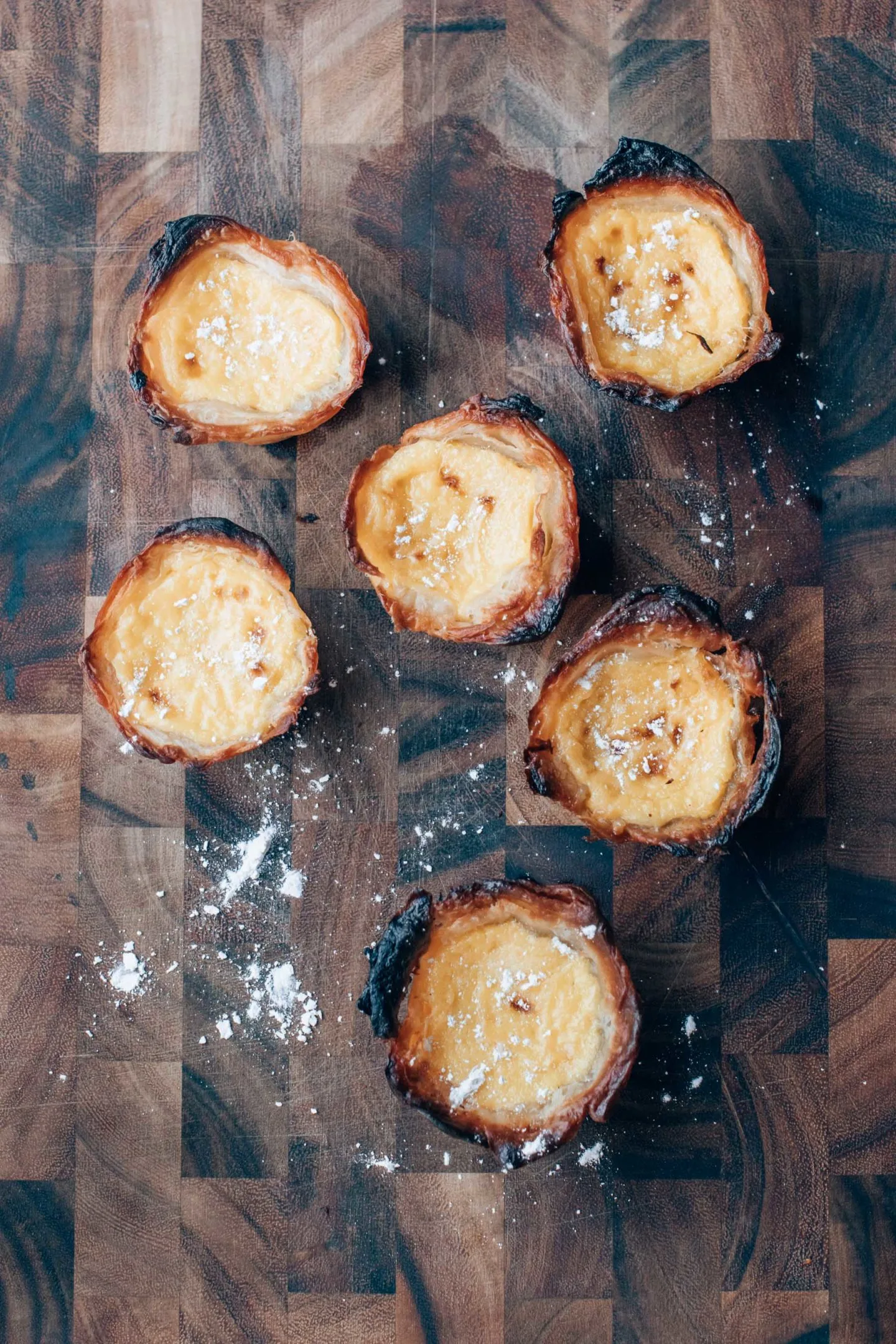
Pasteis de Nata

I've definitely seen these lemon egg Portuguese custard tarts before, but I didn't know what they were called until now. Pasteis de Nata are a traditional Portuguese dessert, and oh em gee, they're awesome.
The process to make the dough is a little bit complicated since you fold the butter in a couple of times and it's just a different technique, so be sure to watch the video in the linked recipe from All Recipes. Be sure to also note that you need to put the dough in the refrigerator for at least 2 hours, ideally overnight, so you'll need to give yourself plenty of time!
Ingredients
For the Dough
- 1 cup all-purpose flour
- 1/4 teaspoon kosher salt
- 1/3 cup cold water
- 1 stick high-quality unsalted butter, fully softened, divided
For the Sugar Syrup
- 3/4 cup white sugar
- 1/4 cup water
- 1 tablespoon water
- 1 cinnamon stick
- 1 lemon, zested in large strips
For the custard base
- 1/3 cup all-purpose flour
- 1/4 teaspoon kosher salt
- 1 1/2 cups milk
- 6 large egg yolks
Instructions
Combine flour, salt, and cold water in a bowl. Mix with a wooden spoon until dough just comes together and pulls away from the sides of the bowl. You may need to add a little more water (I did). Dough should be sticky; adjust with more flour or water to achieve what's shown in the video, linked here.
Transfer dough onto a well floured surface. Dust a little more flour over the top. Knead for a minute or two to form a round. Cover and let rest for 15 to 20 minutes.
Roll dough into a square about 1/8 inch thick, dusting with flour as necessary; dough should still be sticky.
Spread 1/3 of the butter over 2/3 of the square using a silicone spatula, leaving a 1/2 inch border. Flip the unbuttered side over the middle of the square and fold the opposite end over it like a letter. Straighten the edges as needed.
Turn dough with a bench scraper to unstick it from the counter; dust with flour. Flip and sprinkle more flour on top. Roll dough into a 1/8-inch-thick rectangle, carefully stretching edges as needed. Spread another 1/3 of the butter over 2/3 of the dough. Fold into thirds. Transfer onto a lined baking sheet and freeze until butter is slightly chilled, about 10 minutes.
Sprinkle dough with flour and roll into a square a little over 1/8 inch thick. Spread remaining butter over the dough, leaving a 1- to 1 1/2-inch border on the top edge. Dip your finger in water and lightly moisten the unbuttered edge. Roll dough into a log starting from the bottom edge. Dust with more flour and polish the ends as needed. Seal with plastic wrap and refrigerate at least 2 hours, preferably overnight.
Combine sugar, 1/4 cup plus 1 tablespoon water, cinnamon, and lemon zest in a pot. Boil over medium heat, without stirring, until syrup reaches 210 to 215 degrees F (100 degrees C). Remove from heat.
Preheat oven 550 degrees F (288 degrees C). Grease a 12-cup muffin tin.
Whisk flour, salt, and cold milk together very thoroughly in a cold pot. Cook over medium heat, whisking constantly, until milk thickens, about 5 minutes. Remove from heat and let cool for at least 10 minutes.
Whisk egg yolks into the cooled milk. Add the sugar syrup and vanilla extract. Mix until combined. Strain custard into a glass measuring cup.
Unwrap the dough and trim any uneven bits on the ends. Score log into 12 even pieces using a knife; cut through.
Place a piece of dough in each muffin cup. Dip your thumb lightly in some cold water. Press thumb into the center of the swirl; push dough against the bottom and up the sides of the cup until it reaches least 1/8 inch past the top. Fill each cup 3/4 of the way with custard.
Bake in the preheated oven until the pastry is browned and bubbly, and the tops start to blister and caramelize, about 12 minutes. Cool tarts briefly and serve warm.
That wraps up all of my easy Portuguese dishes to try at home in the kitchen. You’ll be cooking like you’re on the food network in no time.
Definitely tag me on Insta @wtfab if you try out any of these popular Portuguese style recipes.
Thank you to Vinho Verde for sponsoring this post!
Looking for more recipes? Try some more here.
Authentic Italian Recipes
Parisian Recipes
Let’s Go to Mexico!
FAQs
Some of the most popular Portuguese recipes are:
– Empadão
– Pasteis de Nata
– Caldo Verde
Traditional Portuguese foods are:
– Alheira De Mirandela
– Bacalhau
– Pasteis de Nata
Portugal is famous for their seafood and meat dishes.

Elise Armitage is an entrepreneur and founder of What The Fab, a travel + lifestyle blog based in California. At the beginning of 2019, Elise left her corporate job at Google to chase her dreams: being an entrepreneur and helping women find fabulous in the everyday. Since then, she’s launched her SEO course Six-Figure SEO, where she teaches bloggers how to create a passive revenue stream from their website using SEO. Featured in publications like Forbes, Elle, HerMoney, and Real Simple, Elise is a firm believer that you can be of both substance and style.


